This month sees the 50th anniversary of the Japanese Shinkansen, the world’s first high speed commercial train service between Tokyo and the western city of Osaka, which opened 1st October 1964.
The blue and white “bullet train” was a resounding success, running at a top speed of 137 mph and cutting the journey time between the two cities from seven to four hours. The train set a new standard in high speed rail travel for other countries to aspire to and became a symbol for Japanese post-war engineering prowess.
Fifty years on and high-speed rail links exist between major cities, in Europe, Asia, and to a lesser extent North America. A recent resurgence in rail travel because of concerns over climate change mean there are many more high speed rail systems in planning and being built across the world. But how have high speed trains developed during the last fifty years? Do the designs differ much from country to country? What will trains look like in the next fifty years?
Our top ten describes the leading high speed trains in the world according to their top speeds. We start with one of the more forward-thinking and controversial train designs in development and end with one of the crowning achievements of the steam age.
The global rail industry. Undoubtedly there are trains missing or trains that deserve honourable mentions on this list. Please feel free to discuss in the comments section below.
-
The Hyperloop
Radically innovative train designs aren’t commonplace in the rail industry, which typically has a conservative attitude towards new technology. So when billionaire industrialist Elon Musk published a design brief for a transportation system that shoots capsules hundreds of miles through a pressurised tube last year, it attracted global media attention.
His proposed “Hyperloop” between San Francisco and Los Angeles would suspend a large steel tube on pylons, from which most of the air would be evacuated. Capsules inside the tube would float on a 1 mm thin bed of air and be accelerated and decelerated to a top speed of 760 mph. Hyperloop’s top speed would be 760 mph and use linear induction motors, of a similar type to those used to propel Maglev trains today. The capsules, each of which would carry 28 passengers, would be fitted with a fan and air compressor to transfer high pressure air from the front to the rear of the capsules. The system would be fuelled by solar panels mounted on the top of the steel tube and batteries. The 354 mile journey between the two cities would take just 35 minutes.
A South African-born physicist turned industrial entrepreneur, Musk is taken seriously - his SpaceX company is developing spacecraft for NASA and his car company Tesla looks set to make good on its early promises in the electric car market. Since he publicised the early Hyperloop design in August 2013, amateur, and some professional engineers, have been debating the weaknesses and benefits of his plan in the media and online. Software companies have run computer simulations, including computational fluid dynamics specialists at Ansys and mathematical computing supplier Mathworks.
Fundamental engineering challenges with the idea usually revolve around dealing with the heat created by the movement of the remaining air within the tube and how it would affect equipment. There are also doubts about the amount of energy the system would require and how high winds would affect the tube and pylon structure and affect the movement of the capsules. However, the biggest challenge facing Hyperloop is said to be that Musk himself will not run the project past the demonstrator stage, because he is too busy with his other ventures and family. Despite this, potential believers can head over to Jumpstartfund to get involved and hand over some money to help fund its development.
-
Maglev
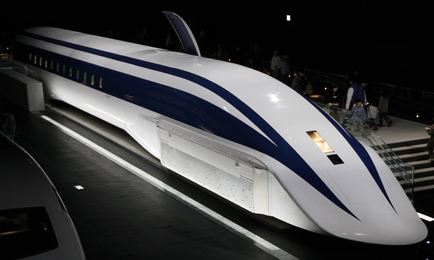
Back in reality the world’s fastest train, JR Central’s MLX01, tops out at 361 mph in Japan. JR Central hopes to have the train running on a 100km line from Tokyo to Kofu in time for the 2020 Olympics. The longer term plan is to build the line out in two phases, to Nagoya by 2025 and Osaka by 2047.
MLX01 uses superconducting magnets in its bogies to induce a current in coils built into guideways either side of the train. The train initially runs on rubber wheels, but once its speed increases to above 93 mph there is enough current to cause it to levitate 100 mm above the guideway. This allows it to increase its speed without being constrained by the friction of wheel-on-rail. Linear motors are used to power a secondary set of coils in the guideway. The coils are also linked together in the track underneath the train. These links are used to correct the train’s position.
MLX01 is an experimental train. If you want to travel on the world’s only commercially operating Maglev train today, the Shanghai Maglev from Pudong International Airport in China will propel you 30.5km in just eight minutes, reaching a top speed of 311 mph. The Shanghai Maglev uses different technology to the Japanese design, developed by Transrapid, a German joint venture between Siemens and ThyssenKrupp. The train wraps around the guideway and the power is supplied by batteries on the train. Superconducting magnets, the related cooling systems and wheels for lower speeds are not required with Transrapid’s system, but the trains are a lot of heavier because of the batteries.
Despite advantages of speed and reliability and decades of research, Maglev technology has failed to rise to prominence because the technology is eye-wateringly expensive. The latest cost-estimate for Japan’s Tokyo to Osaka Maglev line is a staggering £52bn, for a 310 mile high speed train service that won’t be complete until 2045. For considerably less money, governments can buy-in high speed rail that is almost as fast in operation and uses well-proven technology.
-
TGV / AGV (Trains a Grand Vitesse / Advanced Trains a grand vitesse)
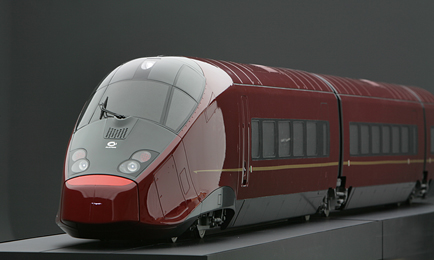
Returning all the way back to earth and wheel-on-rail trains, high speed rail doesn’t come much more proven than France’s TGV (Train à Grande Vitesse). Originally developed in the 1970’s by GEC-Alsthom, several different types and variations have been developed and are in use around the world, a testament to the success of the design. TGV’s success also helped to inspire the development of high speed rail systems throughout Europe, with other countries seeking to emulate the French rail system.
The TGV train introduced many technical innovations to high speed rail, notably articulated trainsets - carriages that share a bogie, high speed brakes and in-cab signalling. The first prototype was designed to be propelled by gas turbines but was abandoned because of high oil prices. The subsequent electric version contained further innovations, including body-mounting traction motors to reduce weight in the power car and a two-stage high speed pantograph.
TGV trains are manufactured today by Alstom and Bombardier. The TGV POS (Paris-Ostfrankreich-Süddeutschland) variant holds the world speed record for conventional rail with a top speed of 357.2 mph. The fastest TGV trains in commercial service run at 199 mph on the East high speed line between Paris and Strasbourg and the Mediterranean high speed line between Lyon and Marseille in France.
Alstom’s AGV (Automotrice à Grande Vitesse) is considered by many to be Europe’s most advanced train and operates with a top speed of 186 mph on different high speed lines in Italy. However the AGV has been run up to 224 mph. The main difference between the TGV and the AGV is the way they are powered. TGV trainsets are “concentrated power” trains, with their main traction equipment in vehicles at each end and a trailer rake between the power cars.
AGV trainsets are distributed power trains - the traction equipment is located all along the trains in the underframe. AGV trains can only be configured as single deck trains, whereas TGV trainsets can be double-decked, “duplex”. According to Alstom, AGV trains have a lower number of bogies per train, reducing maintenance costs, are more efficient, quieter and have more space inside because they use permanent-magnet synchronous motors.
Both trains can operate on lines dedicated to high speed trains and “old” classical networks. TGV trains are in use throughout Central Europe, in Korea, as well as in the US as the Acela Express. They are planned for use in high speed rail lines in Argentina and Morrocco.
-
Harmony CRH380A,
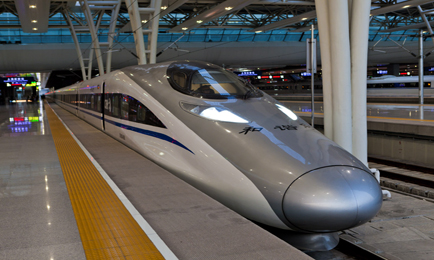
China’s own-brand of conventional wheel high speed train has achieved a top speed of 302 mph and a top operational speed of 236 mph. The train is manufactured by CSR Qingdao Sifang Locomotive and Rolling Stock and was first put into operation in October 2010.
The train was developed by a consortium of Chinese Universities and companies from the CRH2, a Chinese high speed train that itself was based on the Japanese Shinkansen design. The CRH380A is said to be completely vibration-free says CSR, thanks to the use of new materials and an “advanced noise control technology”, with a “low-resistance streamline head”, which features a rotating paraboloid wedge-like structure which reduces air resistance. The train also has an “electro pneumatic compound brake mode” that uses more power from regenerative braking systems.
The independently-developed train is a vital symbol for China, which last decade purchased a number of different high speed trains from international manufacturers including Siemens and Bombardier, but is eager to develop its domestic rail sector. It operates on four high speed lines in China, including the Beijing to Shanghai line.
-
ICE

The German version of the TGV, Deutsche Bahn’s high speed train was developed during the 1980s with the first version of the train entering service in 1991. The most recent version of the train, ICE 3, is made by a consortium headed-up by Siemens and Bombardier. ICE 3 has a top speed of 252.8 mph and an operational top speed of 199 mph.
The train has spawned almost as many variants as the TGV and is mainly used in Germany and the countries that surround it, as well as in Spain, China and Russia, where the entirely-Siemens made ICE-variant, the Velaro E, is run with a top operational speed of 217.5 mph.
Unlike the first two versions, the ICE 3 is different from the ICE 1 and ICE 2 in that its traction motors are distributed beneath the length of the train, similarly to the French AGV, to improve acceleration and give more interior space for passengers. The aerodynamics have also been improved, making the train 20% more efficient, says Siemens. The train is also equipped with frictionless eddy-current brakes, which uses an electromagnet to induce currents within the rails at opposite poles to slow the train.
Deustche Bahn plans to start operating ICE 3 trains from London to Frankfurt via Brussels and from London to Amsterdam in 2015. Journey time to Amsterdam will be less than four hours.
-
Shinkansen

The Grandaddy of high speed rail, the Japanese bullet train was the first high speed train to enter commercial service. Developed and refined over the decades, the latest versions are the E5 and E6 Series Shinkansen, which have top speeds of 248.5 mph.
The original Shinkansen introduced many technical innovations. New tracks were built and dedicated only to high speed trains, with wider gauge rails. Automatic Train Control systems were developed to eliminate the need for trackside signalling. They used electric multiple units for faster acceleration and deceleration and lighter vehicles.
Decades of refinement and technological advancement later and the E5 and E6 series Shinkansen, made by Kawasaki and Hitachi, still offer some of the best performance and an infallible reliability and safety record. According to rail firm JR East the E5 and E6 feature noise insulating panels that quieten the pantographs and bogies under the car body, a refined nose shape that reduces pressure waves and noise, improvements to get more energy from the regenerative braking system and a tilting system that reduces centrifugal forces when passing through curves at high speed.
Shinkansen-based trains have been exported to China, the UK and Taiwan, the THSR 700T, in each case with the train design adapted to the needs of the local infrastructure.
-
Talgo 350
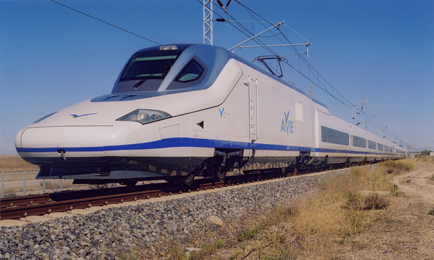
The top speed of the Talgo 350 is 220 mph, although its limited to 205 mph on the lines it operates on in Spain. The train entered service on the Madrid to Barcelona line in 2007 and is manufactured by a consortium headed-up Spanish firm Patentes Talgo and Bombardier. The train is nicknamed “el pato” because of its distinctive beak like flat nose, which is designed to reduce the noise created by air resistance at high speeds.
The train is designed to have a high level of redundancy in traction between rail and auxiliary systems with a lightweight airtight pressurised body to improve comfort through tunnels and crossings. The train also has a very low centre of gravity to improve passenger comfort.
The traction unit uses water cooled IGBT technology and the train has a tilting suspension system that hold the wheels parallel to the track in curved stretches.
The train will be used on the Haramain High Speed Rail Line, which runs along the Muslim pilgrim route between Mecca and Medina in Saudia Arabia. The railway, which will be the Middle East’s first high speed rail line, is expected to open next year.
-
ETR 500
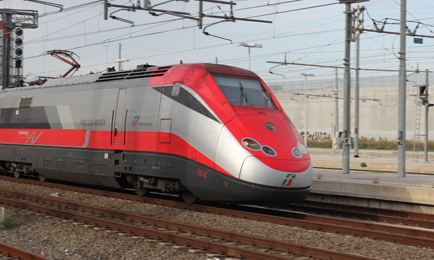
This Italian-made train has a top speed of 223 mph, but also holds the world record for the fastest train in a tunnel, which it achieved in 2009 when it reached the speed of 225 mph on the high-speed line between Bologna and Florence.
The development of the the ETR 500 began in 1985 under the stewardship of the government-owned rail company Ferrovie dello Stato. It was originally developed by design firm Pininfarina and engineering company AnsaldoBreda, who were given the demanding task of developing a train that, unlike the TGV, could travel at more than 186 mph on the same tracks used by conventional trains. The designers produced an aerodynamically streamlined train, with a low drag co-efficient, extensively testing and measuring using specially-developed probes and data recording techniques to create speed and pressure maps of the train’s surface to help the design process.
The train is a pressurised electric multiple unit with locomotives at either end, made of aluminium, steel and composites.
The ETR 500 went into service in Italy in 1993. Today the train is manufactured by a consortium of Alstom, Bombardier and AnsaldoBreda. It connects the main cities such as Turin, Milan, Bologna, Florence, Naples and Salerno with several lines running the updated version of the train, named Frecciarossa, Red Arrow in English.
The ETR 500’s successor, the Frecciarossa 1000, has been developed by AnsaldoBreda and Bombardier and has a design speed of 249 mph. It also features active lateral suspension to improve ride comfort. 50 trains are on order in Italy, with the first expected to enter into service June 2015, when it will become the fastest train in Europe.
-
Intercity 125

The stalwart of the British rail network merits its place on the list by being the fastest diesel train in the world, a record it achieved in 1987 and still holds today for travelling at a speed of 148 mph.
Development of the 125 started during the 1960’s and the first train entered service in 1976. It was manufactured at Litchurch Lane, Derby until 1982. The forty year old design is propelled by diesel-electric power cars, which originally contained 1,678 kW Paxman Valenta engines but were refitted with MTU 16V 4000 engines in 2005. The locomotives had a high power-to-weight ratio with a lighter axle and faster acceleration and deceleration, while crashworthiness was improved and the trains were bi-directional.
The train operates commercially at speeds of up to 125 mph and has proved a resounding success in the UK, only outstipped in the later stages of its lifetime by the better performance, reliability, comfort levels and environmental credentials of electric high speed trains. The electric Intercity 225, which entered into service in 1990, has a top speed of 140mph and has achieved 162 mph during test runs. Both the 125 and 225 Intercity trains are to be replaced by the Super Express Train, a train made by Japanese firm Hitachi from 2017.
-
Mallard steam train,
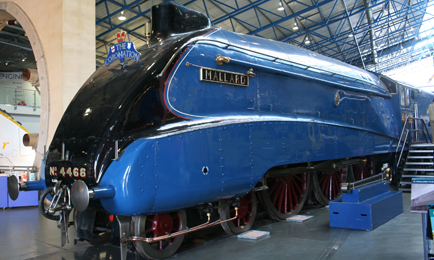
The world’s fastest steam locomotive has held the record for more than 75 years, it was 1938 when the A4 Class Locomotive Mallard travelled at 126 mph on a stretch of track in Yorkshire.
The A4 Class was designed by Nigel Gresley, Chief Mechanical Engineer of the London and North Eastern Railway with the aid of a wind tunnel, which lead to the streamlined body. All of the steam passages internally were also streamlined, and the boiler pressure was increased from the A3’s 220psi to 250psi. Other later additions to the three cylinder locomotive included a Kylchap double-blastpipe exhaust and Westinghouse QSA brake valves. The train also had an eight-wheeled corridor tender to allow the crew access to the train behind, so the team could work shifts without stopping the locomotive.
The Mallard operated on the East Coat Line until 1963. It was restored to working order in the 1980s but is kept on static display at the National Railway Museum in York.